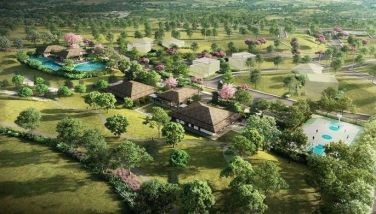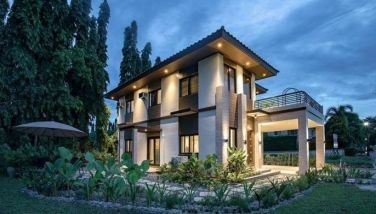Glue-laminated bamboo for structural uses developed
March 20, 2004 | 12:00am
LOS BAÑOs, Laguna – A glue-laminated bamboo and bamboo-wood combination for structural uses have been developed by government researchers here.
The new technology was generated by researchers of the Los Baños-based Forest Products Research and Development (FPRDI) under the Department of Science and Technology (DOST) headed by Director Florence Soriano.
The researchers were Dr. Marina Alipon (project leader), Mildred Fidel, Zenita Espiloy, and Pedro Cayabyab.
They presented the technology at the recent Regional Research and Development (R&D) Symposium of the Southern Tagalog Agriculture and Resources Research and Development Consortium (STARRDEC), one of the 14 government regional R&D consortia coordinated by the Los Baños-based Philippine Council for Agriculture, Forestry and Natural Resources Research and Development (PCARRD).
In the study, the FPRDI researchers used two bamboo species (kauayan-tinik or Bambusa bluemeana and botong or Dendrocalamus latiflorus) and one timber species (yemane or Gmelia arborea).
The samples were laminated using urea formaldehyde (UF) + ammonium chloride (NHcC1) as Glue 1, and UF + NH4C1 + insocyanate as Glue 11.
The researchers noted that between the species used, botong had better bonding strength than kayuayan-tinik.
"There is no significant different between Glue 1 and Glue 11 in shear strength. However, Glue 11 performed better than Glue 1 in wet test," they said.
Strength properties in bending, compression parallel to the grain and shear along glue line of laminated and composite bamboo-wood lamination were also found to be comparable with those of traditional timber species used for general structure purposes such as beams, girders, and flooring.
The strength properties of kauayan-tinik and botong are higher than bamboo-wood laminated (kauayan-tinik-yemane; botong-yemane).
As per FPRD’s strength classification, bamboo laminates generally fall under Class 2 (moderately high) and the bamboo-wood combination under Class 3 (medium strength). They have better strength properties than the Philippine mahogany species traditionally used for construction purposes.
Further, the FPRDI researchers found that the production of glue-laminated bamboo and bamboo-wood combination is technically and economically viable. The economics/cost analysis of producing these new products showed encouraging positive indicators.
They concluded: "The design and fabrication of a mobile flattening machine for bamboo is recommended. Processing can be done in areas were bamboo abounds and can be an additional source of income for rural people."
The new technology was generated by researchers of the Los Baños-based Forest Products Research and Development (FPRDI) under the Department of Science and Technology (DOST) headed by Director Florence Soriano.
The researchers were Dr. Marina Alipon (project leader), Mildred Fidel, Zenita Espiloy, and Pedro Cayabyab.
They presented the technology at the recent Regional Research and Development (R&D) Symposium of the Southern Tagalog Agriculture and Resources Research and Development Consortium (STARRDEC), one of the 14 government regional R&D consortia coordinated by the Los Baños-based Philippine Council for Agriculture, Forestry and Natural Resources Research and Development (PCARRD).
In the study, the FPRDI researchers used two bamboo species (kauayan-tinik or Bambusa bluemeana and botong or Dendrocalamus latiflorus) and one timber species (yemane or Gmelia arborea).
The samples were laminated using urea formaldehyde (UF) + ammonium chloride (NHcC1) as Glue 1, and UF + NH4C1 + insocyanate as Glue 11.
The researchers noted that between the species used, botong had better bonding strength than kayuayan-tinik.
"There is no significant different between Glue 1 and Glue 11 in shear strength. However, Glue 11 performed better than Glue 1 in wet test," they said.
Strength properties in bending, compression parallel to the grain and shear along glue line of laminated and composite bamboo-wood lamination were also found to be comparable with those of traditional timber species used for general structure purposes such as beams, girders, and flooring.
The strength properties of kauayan-tinik and botong are higher than bamboo-wood laminated (kauayan-tinik-yemane; botong-yemane).
As per FPRD’s strength classification, bamboo laminates generally fall under Class 2 (moderately high) and the bamboo-wood combination under Class 3 (medium strength). They have better strength properties than the Philippine mahogany species traditionally used for construction purposes.
Further, the FPRDI researchers found that the production of glue-laminated bamboo and bamboo-wood combination is technically and economically viable. The economics/cost analysis of producing these new products showed encouraging positive indicators.
They concluded: "The design and fabrication of a mobile flattening machine for bamboo is recommended. Processing can be done in areas were bamboo abounds and can be an additional source of income for rural people."
BrandSpace Articles
<
>
- Latest
Latest
Latest
October 23, 2024 - 9:30am
By May Dedicatoria | October 23, 2024 - 9:30am
October 11, 2024 - 3:45pm
October 11, 2024 - 3:45pm
October 10, 2024 - 11:30am
October 10, 2024 - 11:30am
October 5, 2024 - 12:08pm
October 5, 2024 - 12:08pm
September 24, 2024 - 1:00pm
September 24, 2024 - 1:00pm
September 13, 2024 - 4:00pm
September 13, 2024 - 4:00pm
Recommended





























